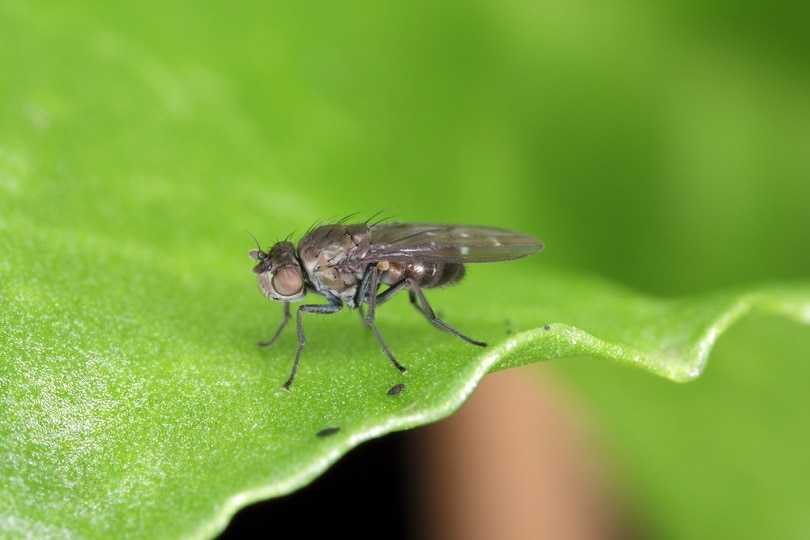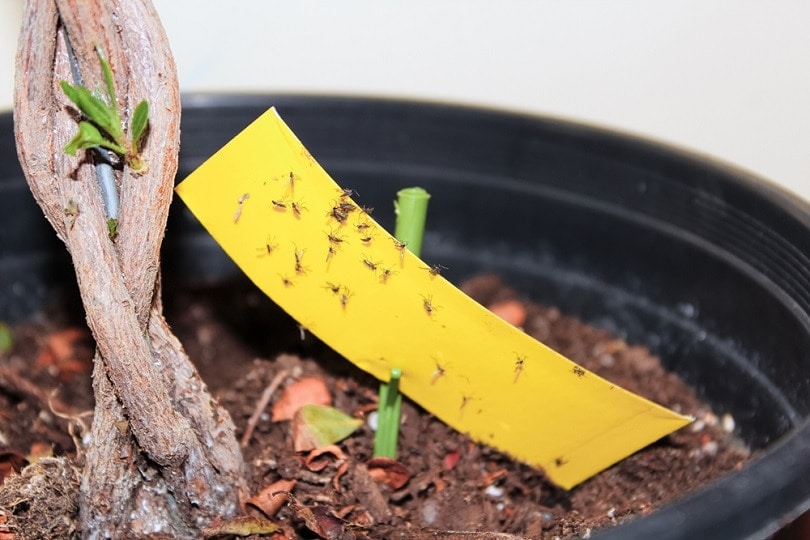How to Get Rid of Gnats in Houseplants (Quick & Easy)
-
- Last updated:


Indoor plants are extremely popular because they brighten up indoor spaces, are known to have mood-boosting qualities, help keep the air in your house fresh, and are an attractive component of many interior designs. They’re also a great option for people with little outdoor space and are usually quite easy to care for, but there is one little thing that many owners of houseplants would rather do without gnats.
Gnats, also commonly known as fungus gnats, are small flying insects about the size of fruit flies that live and breed in the moist soil of potted household plants, feeding on fungus in the soil and rotting root material.
Usually, it will be the adult gnats that you notice first, harmlessly flying around your plants or gathering by a nearby window. But it’s the younger gnats, those still living and feeding in the soil as larvae, that are the most damaging to your plants. 
Gnats or fruit flies?

Fungus gnats are small, black mosquito-like flies that are often mistaken for fruit flies. Despite their similar appearance, gnats and fruit flies are an entirely different insect.
The easiest way to tell them apart is to consider where you see them. Gnats live and breed in the soil and will usually be found flying around and crawling over the soil of your houseplants. On the other hand, fruit flies will be found flying around any fruit you have out, the garbage disposal system, or the kitchen waste bin.

How do gnats get into your houseplants?
To understand this, it’s important to learn about the gnat’s lifecycle. Adult fungus gnats will lay between 200-300 eggs in rich, moist soil. Within 5-6 days, the eggs hatch, and tiny white larvae feed on fungus and plant roots in the soil for about 2 weeks before emerging from the soil to start the breeding process again.
Adult gnats live for about 1 week, and their entire life cycle from egg to death takes just 3-4 weeks. Thus, it is entirely possible to have multiple generations of gnats, in all their life stages, living in and around the soil of your houseplants at the same time.
Gnat eggs and lava are extremely small and exceedingly difficult to see with the naked eye. So, it is entirely possible that potted plants brought in from outside or newly purchased from a nursery can contain gnat eggs and larvae with little or no visible signs of infestation. Also, in their adult state, fungus gnats can simply fly in through an open door or window.

What will fungus gnats do to your houseplants?
Gnats feed on fungus and other organic material in the soil. This often includes the roots of your houseplants, particularly the new roots of seedlings. With each adult female laying up to 300 eggs, it is easy to see how a large gnat infestation can quickly take hold in your houseplants, and thousands of gnat larvae can soon be munching on your plants’ roots.
It is unlikely that gnats will kill your houseplants. Still, an infestation can certainly make them wilt, may cause them to turn yellow, and will almost certainly slow their growth, with seedlings, cuttings, and young plants being the most susceptible to damage.
How to get rid of fungus gnats
You can do several different things to get rid of fungus gnats and ensure that they don’t return to reinfest your houseplants in the future. These fall into three basic categories: prevention, removing the adult gnats, and targeting the larvae. To completely eradicate fungus gnats, it is likely that you will need to employ tactics from each category.
- Prevention is better than cure
When it comes to controlling gnats in indoor plants, preventing an infestation from occurring in the first place is certainly preferable to treating a problem later. There are a few simple steps that you can take that will go a long way toward preventing a gnat infestation in your houseplants.
- Inspect new plants before purchasing
It may sound simple, but taking a few moments to carefully inspect any new plants for signs of gnats before purchasing them is well worth the effort. Gnat flies can be easy to spot flying around the plants and crawling on the soil.
Less obvious will be the larvae in the soil. Fungus gnat larvae have blackheads and elongated whitish, almost transparent bodies and grow up to around 1/4 inch long. They can be quite difficult to spot, but another sign that your potential new plant has gnats is that there may be a slime trail, similar to that left by a slug or snail, across the surface of the soil.
If the plants you are looking at have any of these signs, reject them and consider purchasing plants from a different nursery or garden center.
- Avoid overwatering your plants
Fungus gnats thrive in damp soil, so one of the best ways to prevent them is to ensure that you allow the plant’s soil to dry out to a depth of 1-2 inches before watering. Allowing the soil to dry out in this matter will kill any larvae and inhibit egg development, and it will also discourage any flying gnats that make it into your home through open doors or windows from laying their eggs in your plants.
- Top dress your houseplants
Adding a simple top dressing of sand or a gnat barrier like Gnat Nix, a product made from recycled glass, to your houseplants will significantly reduce the chance of gnat flies laying their eggs in your soil.

Eradicate the adult gnat flies
The adult gnat flies are much easier to see than the larvae and easier to kill off, and targeting the adults makes it possible to significantly affect the fungus gnats’ breeding and life cycles and reduce their impact on your houseplants.
Unfortunately, while getting rid of the flies is relatively easy, there will likely be a new batch that emerges from the soil to reproduce and lay more eggs within a few days. Thus, it can seem like a losing battle if you only target the adult flies. Still, your chances of completely eliminating the fungus gnats will increase if you employ several different approaches.
- Kill the flies with an insect spray
The simplest method, one that many people use when they find a group of flies hanging around their windows, is to spray them with a flying insect spray. There are many different sprays available from your local supermarket, and any one of them will kill these flies.
However, most commercially manufactured insect sprays are made from harmful chemicals. An alternative to using a commercial fly spray is to mix a solution containing peppermint, cinnamon, and sesame oils with a bit of water and to use a trigger spray bottle to spray the flies. This all-natural combination is completely non-toxic and will dispatch any flies or other insects around your windows.
- Use yellow gnat tape
Fungus gnats are attracted to the color yellow, and there are a variety of sticky yellow flypapers and tapes that have been developed for gnats. Some of these are designed to be laid directly across the soil, and others come in small sticks that can be stuck into the soil.
The idea of these products is that the yellow gnat tape is placed as close to where the gnat flies emerge from the soil, so they fly directly to the attractive tape and get stuck and die there before they have time to breed and lay new eggs.
- Destroy the larvae
Targeting the fungus gnats while they are still in their larvae stage won’t give you an immediate reduction in the number of gnats flies that you see flying around your plants and windows, but it is a much better method of controlling gnats than simply killing off all the adult flies.
As you might expect, there are many different methods of killing gnat larvae. The method that is right for you will have more to do with how comfortable you are using chemicals and biological solutions in your home rather than how effective it is.
- Hit them with the chemicals
There are many different gardening chemicals that you can purchase that will kill the gnat larvae, and many will stay in the soil long enough to completely break the life cycle of the gnats. You should have no problem identifying several gnat control products with a quick internet search or a call to your local gardening center.
Most chemical solutions are highly effective and provided that you follow the directions, they will not harm your plants. However, care should be taken when using and storing gardening chemicals, as many of them are toxic to both humans and pets and can result in accidental poisoning if they are not handled carefully.
- Employ a hunter-killer bug
Several different types of bugs can be purchased and deliberately released onto your plants to hunt down and kill fungus gnat larvae.
The most popular of these is the Hypoaspis (Stratiolaelaps scimitus, formerly Hypoaspis miles), also known as the fungus gnat predator. These small predatory mites feed on the fungus gnat and several other soft-bodied organisms that live in the soil. They are typically sold in tubes containing about 20,000 mites, enough to treat about 2,500 square feet of soil. Hypoaspis mites are used worldwide and are an extremely popular method of controlling fungus gnats in commercial greenhouses and nurseries.
Another biological solution is to employ beneficial nematodes (Steinernema feltiae). Nematodes are tiny, cylindrical roundworms that live in soils around the world. Unlike hypoaspis mites, nematodes don’t hunt and kill the gnats; they enter the gnats through their body openings and quickly multiple within their hosts, releasing a toxin that kills gnats within 1 or 2 days. Over the following week, newly born juvenile nematodes exit their host’s dead body and search for a new host to infect.
Nematodes are quite effective at controlling fungus gnat infestations in indoor house plants, but if you have many plants or a greenhouse to look after, we recommend the Hypoaspis, which truly is a commercial-grade fungus gnat predator.
- Remove the infested soil
One of the simplest ways to get rid of the gnat larvae in your houseplants is to remove the top 3 inches of soil in your pots and replace it with sterile potting mix before bringing your plants into the house. As a rule, you should do this every time you bring a plant into the house, either one that’s newly bought from a nursery or one that has been outside for the summer.
Remember to only use fresh, sterile potting mix—it doesn’t cost much, and it is the only way you can ensure that you’re not going to reinfest your plants. It is also important to completely seal any open potting mix bags before storing them in a cool, dry place.
See Also:
- How to Get Rid of Gnats in the Bathroom (4 Quick & Simple Ways)
- How to Get Rid of Gnats Outside (Fast & Easy)
- Why Are There Gnats In My House (And How Do I Get Them Out?)
Featured Image Credit: MarcOliver_Artworks, Shutterstock
Contents

